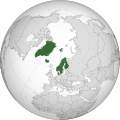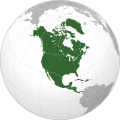Greenland
This article needs additional citations for verification. (October 2023) |
Greenland | ||
|---|---|---|
| Religion | High Commissioner | Julie Præst Wilche |
| Múte Bourup Egede | ||
| Mimi Karlsen | ||
| Legislature | UTC-04:00 | |
| Date format | dd-mm-yyyy | |
| Driving side | right | |
| Calling code | +299 | |
| Postal codes | 39xx | |
| ISO 3166 code | GL | |
| Internet TLD | .gl | |
Greenland (
Though a part of the continent of North America, Greenland has been politically and culturally associated with Europe (specifically Norway and Denmark, the colonial powers) for more than a millennium, beginning in 986.[18] Greenland has been inhabited at intervals over at least the last 4,500 years by circumpolar peoples whose forebears migrated there from what is now Canada.[19][20] Norsemen settled the uninhabited southern part of Greenland beginning in the 10th century (having previously settled Iceland), and the 13th century saw the arrival of Inuit. Though under continuous influence of Norway and Norwegians, Greenland was not formally under the Norwegian crown until 1261. The Norse colonies disappeared in the late 15th century, after Norway was hit by the Black Death and entered a severe decline.
In the early 17th century, Dano-Norwegian explorers reached Greenland again. When Denmark and Norway separated in 1814, Greenland was transferred to the Danish crown, and was fully integrated in the Danish state in 1953 under the Constitution of Denmark, which made the people in Greenland citizens of Denmark. In the 1979 Greenlandic home rule referendum, Denmark granted home rule to Greenland; in the 2008 Greenlandic self-government referendum, Greenlanders voted for the Self-Government Act, which transferred more power from the Danish government to the local Naalakkersuisut (Greenlandic government).[21] Under this structure, Greenland gradually assumed responsibility for a number of governmental services and areas of competence. The Danish government retains control of citizenship, monetary policy, and foreign affairs, including defence. Most residents of Greenland are Inuit.[22]
The population is concentrated mainly on the southwest coast, and the rest of the island is sparsely populated. Three-quarters of Greenland is covered by the only permanent ice sheet outside Antarctica. With a population of 56,583 (2022),[23] Greenland is the least densely populated region in the world.[24] 67% of its electricity production comes from renewable energy, mostly from hydropower.[25]
Etymology

The early Norse settlers named the island Greenland. In the Icelandic sagas, the Norwegian Erik the Red was exiled from Iceland with his father, Thorvald, who had committed manslaughter. With his extended family and his thralls (slaves or serfs), he set out in ships to explore an icy land known to lie to the northwest. After finding a habitable area and settling there, he named it Grœnland (translated as "Greenland"), supposedly in the hope that the pleasant name would attract settlers.[26][27][28] The Saga of Erik the Red states: "In the summer, Erik left to settle in the country he had found, which he called Greenland, as he said people would be attracted there if it had a favorable name."[29]
The name of the territory in the Greenlandic language is Kalaallit Nunaat 'land of the Kalaallit'.[30] The Kalaallit are the Greenlandic Inuit who inhabit the territory's western region.
In World War II, the United States military used Bluie as a code name for Greenland, where they kept several bases named "Bluie (East or West) (sequential numeral)".[31]
History
Early Paleo-Inuit cultures

In prehistoric times, Greenland was home to several successive
From 2400 BC to 1300 BC, the Independence I culture existed in northern Greenland. It was a part of the Arctic small-tool tradition.[34][35][36] Towns, including Deltaterrasserne, appeared. About 800 BC, the Saqqaq culture disappeared and the Early Dorset culture emerged in western Greenland and the Independence II culture in northern Greenland.[37] The Dorset culture was the first culture to extend throughout the Greenlandic coastal areas, in the west and the east. It lasted until the total onset of the Thule culture, in AD 1500. The people of the Dorset culture lived mainly by hunting whales and reindeer.[38][39][40][41]
Norse settlement

From 986, the west coast was settled by Icelanders and Norwegians, through a contingent of 14 boats led by Erik the Red. They formed three settlements—the Eastern Settlement, the Western Settlement, and the Middle Settlement—on fjords near the southwestern tip of the island.[18][42] They shared the island with the late Dorset culture inhabitants, who occupied the northern and western parts, and later with those of the Thule culture, who entered from the north. Norse Greenlanders submitted to Norwegian rule in 1261 under the Kingdom of Norway.[43] The Kingdom of Norway entered a personal union with Denmark in 1380, and from 1397 was a part of the Kalmar Union.[44]
The Norse settlements, such as
Icelandic saga accounts of life in Greenland were composed in the 13th century and later, and are not primary sources for the history of early Norse Greenland.[28] Those accounts are closer to primary for more contemporaneous accounts of late Norse Greenland. Modern understanding therefore mostly depends on the physical data from archeological sites. Interpretation of ice-core and clam-shell data suggests that between AD 800 and 1300 the regions around the fjords of southern Greenland had a relatively mild climate, several degrees Celsius warmer than usual in the North Atlantic[46] with trees and herbaceous plants growing and livestock being farmed. Barley was grown as a crop up to the 70th parallel.[47] The ice cores show that Greenland has had dramatic temperature shifts many times in the past 100,000 years.[48] Similarly the Icelandic Book of Settlements records famines during the winters, in which "the old and helpless were killed and thrown over cliffs".[46]
These Norse settlements vanished during the 14th and early 15th centuries.[49] The demise of the Western Settlement coincides with a decrease in summer and winter temperatures. A study of North Atlantic seasonal temperature variability during the Little Ice Age showed a significant decrease in maximum summer temperatures beginning about the turn of the 14th century—as much as 6 to 8 °C (11 to 14 °F) lower than modern summer temperatures.[50] The study also found that the lowest winter temperatures of the last 2,000 years occurred in the late 14th century and early 15th century. The Eastern Settlement was probably abandoned in the early to mid-15th century, during this cold period.
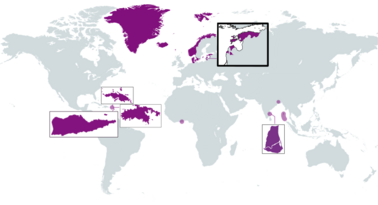

Theories drawn from archeological excavations at Herjolfsnes in the 1920s suggest that the condition of human bones from this period indicates that the Norse population was malnourished, possibly because of soil erosion resulting from the Norsemen's destruction of natural vegetation in the course of farming, turf-cutting, and wood-cutting. Malnutrition may also have resulted from widespread deaths from pandemic plague;[51] the decline in temperatures during the Little Ice Age; and armed conflicts with the Skrælings (Norse word for Inuit, meaning "wretches"[45]). Recent archeological studies somewhat challenge the general assumption that the Norse colonization had a dramatic negative environmental effect on the vegetation. Data support traces of a possible Norse soil amendment strategy.[52] More recent evidence suggests that the Norse, who never numbered more than about 2,500, gradually abandoned the Greenland settlements over the 15th century as walrus ivory,[53] the most valuable export from Greenland, decreased in price because of competition with other sources of higher-quality ivory, and that there was actually little evidence of starvation or difficulties.[54]
Other explanations of the disappearance of the Norse settlements have been proposed:
- Lack of support from the homeland.[51]
- Ship-borne marauders (such as Basque, English, or German pirates) rather than Skrælings, could have plundered and displaced the Greenlanders.[55]
- They were "the victims of hidebound thinking and of a hierarchical society dominated by the Church and the biggest land owners. In their reluctance to see themselves as anything but Europeans, the Greenlanders failed to adopt the kind of apparel that the Inuit employed as protection against the cold and damp or to borrow any of the Inuit hunting gear."[18][45]
- That portion of the Greenlander population willing to adopt Inuit ways and means intermarried with and assimilated into the Inuit community.[56] Much of the Greenland population today is mixed Inuit and European ancestry. It was impossible in 1938 when Stefansson wrote his book to distinguish between intermarriage before the European loss of contact and after the contact was restored.
- "Norse society's structure created a conflict between the short-term interests of those in power, and the long-term interests of the society as a whole."[45]
Thule culture (1300–present)

The Thule people are the ancestors of the current Greenlandic population. No genes from the Paleo-Inuit have been found in the present population of Greenland.[57] The Thule culture migrated eastward from what is now known as Alaska around 1000 AD, reaching Greenland around 1300. The Thule culture was the first to introduce to Greenland such technological innovations as dog sleds and toggling harpoons.
There is an account of contact and conflict with the Norse population, as told by the Inuit. It is republished in The Norse Atlantic Sagas, by Gwyn Jones. Jones reports that there is also an account of perhaps the same incident, of more doubtful provenance, told by the Norse side.
1500–1814
In 1500, King
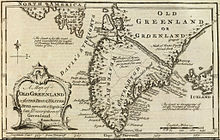
In 1605–1607, King
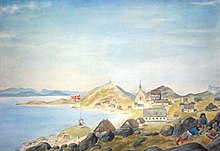
After the Norse settlements died off, Greenland came under the de facto control of various Inuit groups, but the Dano-Norwegian government never forgot or relinquished the claims to Greenland that it had inherited from the Norse. When it re-established contact with Greenland in the early 17th century, Denmark-Norway asserted its sovereignty over the island. In 1721 a joint mercantile and clerical expedition led by Dano-Norwegian missionary Hans Egede was sent to Greenland, not knowing whether a Norse civilization remained there. This expedition is part of the Dano-Norwegian colonization of the Americas. After 15 years in Greenland, Hans Egede left his son Paul Egede in charge of the mission there and returned to Denmark, where he established a Greenland Seminary. This new colony was centred at Godthåb ("Good Hope") on the southwest coast. Gradually, Greenland was opened up to Danish merchants, but closed to those from other countries.
Treaty of Kiel to World War II (1814–1945)
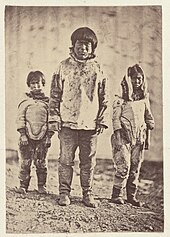
When the union between the crowns of Denmark and Norway was dissolved in 1814, the Treaty of Kiel severed Norway's former colonies and left them under the control of the Danish monarch. Norway occupied then-uninhabited eastern Greenland as Erik the Red's Land in July 1931, claiming that it constituted terra nullius. Norway and Denmark agreed to submit the matter in 1933 to the Permanent Court of International Justice, which decided against Norway.[59]
Greenland's connection to Denmark was severed on 9 April 1940, early in

During this war, the system of government changed:
Greenland had been a protected and very isolated society until 1940. The Danish government had maintained a strict monopoly of Greenlandic trade, allowing no more than small scale barter trading with British whalers. In wartime Greenland developed a sense of self-reliance through self-government and independent communication with the outside world. Despite this change, in 1946 a commission including the highest Greenlandic council, the Landsrådene, recommended patience and no radical reform of the system. Two years later, the first step towards a change of government was initiated when a grand commission was established. A final report (G-50) was presented in 1950, which recommended the introduction of a modern welfare state with Denmark's development as sponsor and model. In 1953, Greenland was made an equal part of the Danish Kingdom. Home rule was granted in 1979.
Home rule and self-rule

In 1867,

In 1950, Denmark agreed to allow the US to regain the use of
With the 1953 Danish constitution, Greenland's colonial status ended as the island was incorporated into the Danish realm as an

This gave Greenland limited autonomy with
On 21 June 2009, Greenland gained self-rule with provisions for assuming responsibility for self-government of judicial affairs, policing, and natural resources. Also, Greenlanders were recognized as a separate people under international law.[76] Denmark maintains control of foreign affairs and defence matters. Denmark upholds the annual block grant of 3.2 billion Danish kroner, but as Greenland begins to collect revenues of its natural resources, the grant will gradually be diminished. This is generally considered to be a step toward eventual full independence from Denmark.[77] Greenlandic was declared the sole official language of Greenland at the historic ceremony.[2][4][78][79][80]
Tourism
Tourism increased significantly between 2015 and 2019, with the number of visitors increasing from 77,000 per year to 105,000.[81] One source estimated that in 2019 the revenue from this aspect of the economy was about 450 million kroner (US$67 million). Like many aspects of the economy, this slowed dramatically in 2020 and into 2021, due to restrictions required as a result of the COVID-19 pandemic;[82] one source describes it as being the "biggest economic victim of the coronavirus" (the overall economy did not suffer too severely as of mid-2020, thanks to the fisheries "and a hefty subsidy from Copenhagen").[83] Greenland's goal for returning tourism is to develop it "right" and to "build a more sustainable tourism for the long run".[84]
Geography and climate

Greenland is the world's
The lowest temperature ever recorded in the
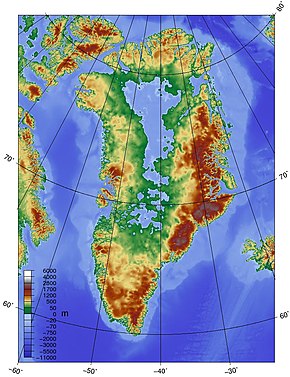
The weight of the ice sheet has depressed the central land area to form a basin lying more than 300 m (980 ft) below sea level,[91][92] while elevations rise suddenly and steeply near the coast.[93]
The ice
All towns and settlements of Greenland are situated along the ice-free coast, with the population being concentrated along the west coast. The northeastern part of Greenland is not part of any municipality, but it is the site of the world's largest national park, Northeast Greenland National Park.[95]
At least four scientific expedition stations and camps had been established on the ice sheet in the ice-covered central part of Greenland (indicated as pale blue in the adjacent map): Eismitte, North Ice, North GRIP Camp and The Raven Skiway. There is a year-round station Summit Camp on the ice sheet, established in 1989. The radio station Jørgen Brønlund Fjord was, until 1950, the northernmost permanent outpost in the world.
The extreme north of Greenland, Peary Land, is not covered by an ice sheet, because the air there is too dry to produce snow, which is essential in the production and maintenance of an ice sheet. If the Greenland ice sheet were to melt away completely, the world's sea level would rise by more than 7 m (23 ft).[96]
In 2003, a small island, 35 m × 15 m (115 ft × 49 ft) in length and width, was discovered by arctic explorer Dennis Schmitt and his team at the coordinates of 83-42. Whether this island is permanent is not yet confirmed. If it is, it is the northernmost permanent known land on Earth.
In 2007, the existence of a new island was announced. Named "Uunartoq Qeqertaq" (English: Warming Island), this island has always been present off the coast of Greenland, but was covered by a glacier. This glacier was discovered in 2002 to be shrinking rapidly, and by 2007 had completely melted away, leaving the exposed island.[97] The island was named Place of the Year by the Oxford Atlas of the World in 2007.[98] Ben Keene, the atlas's editor, commented:
In the last two or three decades, global warming has reduced the size of glaciers throughout the Arctic and earlier this year, news sources confirmed what climate scientists already knew: water, not rock, lay beneath this ice bridge on the east coast of Greenland. More islets are likely to appear as the sheet of frozen water covering the world's largest island continues to melt.[99]
Some controversy surrounds the history of the island, specifically over whether the island might have been revealed during a brief warm period in Greenland during the mid-20th century.[100]
Climate change

Greenland ice sheet always loses some mass from ice calving at its coasts, but it used to gain more ice on average due to the accumulation of snowfall.[101] Yet, Greenland has been warming starting from around 1900,[102] and starting from 1980s, the losses became larger than the gains.[103] After 1996, Greenland has not had a single year when it did not lose mass on average.[104] In 2010s, Greenland ice sheet had been melting at its fastest rate over at least the past 12,000 years, and on track to exceed that later in the century.[105] In 2012, 2019 and 2021, so-called "massive melting events" had occurred, when practically the entire surface of the ice sheet had been melting and no accumulation had been taking place.[106][107][108] During the 2021 event, rain fell at Greenland's highest point for the first time in recorded history: an event so unexpected that the research station at the summit had no rain gauges for the occasion.[109]
As with the ice losses elsewhere, the melting of Greenland contributes to sea level rise. Between 2012 and 2017, this melting had added an average of 0.68 mm per year,[110] which was equivalent to 37% of sea level rise from land ice sources (excluding thermal expansion of water from the continual increase in the ocean heat content).[111] By the end of the century, the melting of Greenland alone would add between ~6 cm (2+1⁄2 in) if the temperatures are kept below 2 °C (3.6 °F), to around 13 cm (5 in) if the most intense climate change scenario with ever-increasing greenhouse gas emissions is followed.[112]: 1302 Under this scenario, the worst case for Greenland melting could reach 33 cm (13 in) of sea level rise equivalent.[113] The large quantities of fresh meltwater also affect the Atlantic meridional overturning circulation, or AMOC, by diluting key currents, slowing it down.[114][115] Due to this meltwater input, the circulation may even collapse outright, with widespread detrimental effects, although research suggests this is only likely if highest possible warming is sustained for multiple centuries.[116][117]
Greenland ice sheet has a great volume of ~2,900,000 cubic kilometres (696,000 cu mi). This means that if it were all to melt, the global sea levels would increase by ~7.4 m (24 ft) from that alone.[119] However, it also means that it will take at least 1,000 years for the ice sheet to disappear even with very high warming,[113] and in around 10,000 years under lower warming which still crosses the threshold for the ice sheet's disappearance.[120][121] This threshold likely lies for the global warming between 1.7 °C (3.1 °F) and 2.3 °C (4.1 °F). Reducing the warming back to 1.5 °C (2.7 °F) above preindustrial levels or lower (i.e. through large-scale carbon dioxide removal) would arrest the losses, but still cause greater ultimate sea level rise than if the threshold had never been exceeded.[122] Further, 1.5 °C (2.7 °F) itself appears to commit the ice sheet to 1.4 m (4+1⁄2 ft) of sea level rise.[123]
Geology
The island was part of the very ancient Precambrian continent of Laurentia, the eastern core of which forms the Greenland Shield, while the less exposed coastal strips become a plateau. On these ice-free coastal strips are sediments formed in the Precambrian, overprinted by metamorphism and now formed by glaciers, which continue into the Cenozoic and Mesozoic in parts of the island.
In the east and west of Greenland there are remnants of flood
To the west and southwest are
The paleontology of East Greenland is specially rich, with some of the early tetrapods[126] such as the Devonian Acanthostega and Ichthyostega, and unique triassic animals such as the phytosaur Mystriosuchus alleroq[127] and the dinosaurs Issi saaneq[128] and tracks.[129]
Biodiversity
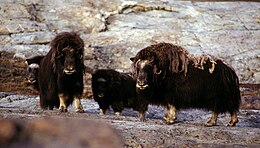
Greenland is home to two ecoregions:
Phytogeographically, Greenland belongs to the Arctic province of the Circumboreal Region within the Boreal Kingdom. The island is sparsely populated in vegetation; plant life consists mainly of grassland and small shrubs, which are regularly grazed by livestock. The most common tree native to Greenland is the European white birch (Betula pubescens) along with gray-leaf willow (Salix glauca), rowan (Sorbus aucuparia), common juniper (Juniperus communis) and other smaller trees, mainly willows.
Greenland's flora consists of about 500 species of "higher" plants, i.e.

The terrestrial vertebrates of Greenland include the

As of 2009, 269 species of fish from over 80 different families are known from the waters surrounding Greenland. Almost all are marine species with only a few in freshwater, notably Atlantic salmon and charr.[134] The fishing industry is the primary industry of Greenland's economy, accounting for the majority of territory's total exports.[135]
Birds, particularly seabirds, are an important part of Greenland's animal life; they consist of both
Politics

The Greenlandic government holds
In contemporary times, elections are held at municipal, national (Inatsisartut), and kingdom (Folketing) levels.
Greenland is a self-governing entity within the
Political system
The party system was dominated by the social-democratic
The non-binding 2008 referendum on self-governance favouring increased self-governance and autonomy was passed winning 76.22% of the vote.
In 1985,
Government
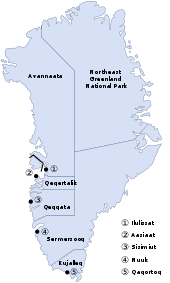
Greenland's
The Greenland constituency elect two
Greenland has national
Military
Several American and Danish military bases are located in Greenland, including
In 1995, a political scandal in Denmark occurred after a report revealed the government had given tacit permission for nuclear weapons to be located in Greenland, in contravention of Denmark's 1957 nuclear-free zone policy.[150][70] The United States built a secret nuclear powered base, called Camp Century, in the Greenland ice sheet.[151] On 21 January 1968, a B-52G, with four nuclear bombs aboard as part of Operation Chrome Dome, crashed on the ice of the North Star Bay while attempting an emergency landing at Thule Air Base.[152] The resulting fire caused extensive radioactive contamination.[153] One of the H-bombs remains lost.[154][155]
Administrative divisions
Formerly consisting of three counties comprising a total of 18 municipalities, Greenland abolished these in 2009 and has since been divided into large territories known as "municipalities" (Greenlandic: kommuneqarfiit, Danish: kommuner): Sermersooq ("Much Ice") around the capital Nuuk and also including all East Coast communities; Kujalleq ("South") around Cape Farewell; Qeqqata ("Centre") north of the capital along the Davis Strait; Qeqertalik ("The one with islands") surrounding Disko Bay; and Avannaata ("Northern") in the northwest; the latter two having come into being as a result of the Qaasuitsup municipality, one of the original four, being partitioned in 2018. The northeast of the island composes the unincorporated Northeast Greenland National Park. Pituffik Space Base is also unincorporated, an enclave within Avannaata municipality administered by the United States Space Force. During its construction, there were as many as 12,000 American residents but in recent years the number has been below 1,000.
Economy
The Greenlandic economy is highly dependent on fishing. Fishing accounts for more than 90% of Greenland's exports.[156] The shrimp and fish industry is by far the largest income earner.[157]
Greenland is abundant in minerals.
Electricity has traditionally been generated by oil or diesel power plants, even if there is a large surplus of potential hydropower. There is a programme to build hydropower plants. The first, and still the largest, is Buksefjord hydroelectric power plant.
There are also plans to build a large aluminium smelter, using hydropower to create an exportable product. It is expected that much of the labour needed will be imported.[159]
The
The public sector, including publicly owned enterprises and the municipalities, plays a dominant role in Greenland's economy. About half the government revenues come from grants from the Danish government, an important supplement to the gross domestic product (GDP). Gross domestic product per capita is equivalent to that of the average economies of Europe.
Greenland suffered an economic contraction in the early 1990s. But, since 1993, the economy has improved. The Greenland Home Rule Government (GHRG) has pursued a tight fiscal policy since the late 1980s, which has helped create surpluses in the public budget and low inflation. Since 1990, Greenland has registered a foreign-trade deficit following the closure of the last remaining lead and zinc mine that year. In 2017, new sources of ruby in Greenland have been discovered, promising to bring new industry and a new export from the territory[161] (see Gemstone industry in Greenland).
Transport
There is air transport both within Greenland and between the island and other
A 1-lane dirt road designed primarily for all-terrain vehicles (secondarily for bicycles and hiking), is under construction between Kangerlussuaq Airport and the town of Sisimiut. As of June 2023, the road was scheduled for completion in 2024.[163] A news report in Sermitsiaq declared the road itself to be completed already in September 2021,[164] but maintenance work and mud problems[165] have caused delays. There are plans to extend the road to a 2-lane gravel road, but a date for its construction start has not been announced.[166]
Kangerlussuaq Airport (SFJ)[167] is the largest airport and the main aviation hub for international passenger transport. It serves international and domestic airline operated flight.[168] SFJ is far from the vicinity of the larger metropolitan capital areas, 317 km (197 mi) to the capital Nuuk, and airline passenger services are available.[169]
Nuuk Airport (GOH)[170] is the second-largest airport, located just 6.0 km (3.7 mi) from the centre of the capital. GOH serves general aviation traffic and has daily or regular domestic flights within Greenland. GOH also serves international flights to Iceland, business, and private airplanes.
Ilulissat Airport (JAV)[171] is a domestic airport that also serves international flights to Iceland.
There are a total of 13 registered civil airports and 47 helipads in Greenland; most of them are unpaved and located in rural areas. The second-longest runway is at
Icelandair operates flights from Reykjavík to a number of airports in Greenland, and the company promotes the service as a day-trip option from Iceland for tourists.[172]
There are no direct flights to the United States or Canada, although there have been flights Kangerlussuaq – Baltimore,[173] and Nuuk – Iqaluit,[174] which were cancelled because of too few passengers and financial losses.[175] An alternative between Greenland and the United States/Canada is Icelandair with a plane change in Iceland.[176]
Sea passenger transport is served by several coastal ferries. Arctic Umiaq Line makes a single round trip per week, taking 80 hours each direction.[177]
Cargo freight by sea is handled by the shipping company Royal Arctic Line from, to and across Greenland. It provides trade and transport opportunities between Greenland, Europe and North America.
Population
Demographics

As of 2021, Greenland has a population of 56,421.[178] That same year, 18,800 people resided in the capital city Nuuk. Nearly all Greenlanders live along the fjords in the south-west of the main island, which has a relatively mild climate, especially considering the high latitude upon which it lies.[179] Whereas the majority of the population lives north of 64°N in colder coastal climates, Greenland's warmest climates such as the vegetated area around Narsarsuaq are sparsely populated.
The majority of the population is Lutheran. The historically important Moravian Brothers (Herrnhuters) were a congregation of faith, in a Danish context based in Christiansfeld in South Jutland, and partially of German origin, but their name does not signify they were ethnic Moravians (Czechs).
In terms of country of birth, the population is estimated to be of 89.7%
A 2015 wide genetic study of Greenlanders found modern-day Inuit in Greenland are direct descendants of the first Inuit pioneers of the Thule culture who arrived in the 13th century, with approximately 25% admixture of the European colonizers from the 16th century. Despite previous speculations, no evidence of Viking settlers predecessors has been found.[180]
Greenland is the only territory in the Americas where natives make up a majority of the population.
| Rank | Name
|
Municipality | Pop. | Rank | Name
|
Municipality | Pop. | ||
|---|---|---|---|---|---|---|---|---|---|
 Nuuk  Sisimiut |
1 | Nuuk | Sermersooq | 18,326 | 11 | Nanortalik | Kujalleq | 1,185 |  Ilulissat  Aasiaat |
| 2 | Sisimiut | Qeqqata | 5,582 | 12 | Upernavik | Avannaata | 1,092 | ||
| 3 | Ilulissat | Avannaata | 4,670 | 13 | Qasigiannguit | Qeqertalik | 1,081 | ||
| 4 | Aasiaat | Qeqertalik | 3,069 | 14 | Qeqertarsuaq | Qeqertalik | 839 | ||
| 5 | Qaqortoq | Kujalleq | 3,050 | 15 | Qaanaaq | Avannaata | 646 | ||
| 6 | Maniitsoq | Qeqqata | 2,534 | 16 | Kangaatsiaq | Qeqertalik | 520 | ||
| 7 | Tasiilaq | Sermersooq | 2,063 | 17 | Kangerlussuaq | Qeqqata | 508 | ||
| 8 | Uummannaq | Avannaata | 1,407 | 18 | Kullorsuaq | Avannaata | 453 | ||
| 9 | Narsaq | Kujalleq | 1,346 | 19 | Ittoqqortoormiit | Sermersooq | 345 | ||
| 10 | Paamiut | Sermersooq | 1,308 | 20 | Kangaamiut | Qeqqata | 293 | ||
Languages
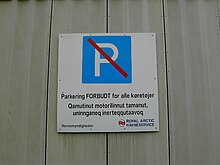
A majority of the Greenland population speak West Greenlandic (Kalaallisut) bi- and some tri-lingually which is more than all other languages combined. About 12% of the population speak Danish as a first or sole language. These primarily are Danish immigrants, many of whom remain the first and only language for those in Nuuk and other larger towns. Debate about the roles of Greenlandic and Danish in the country's future is evolving. While Greenlandic was dominant in all smaller settlements, most of the multi ethnic Inuit ancestors spoke Danish as a second language. In larger towns, especially Nuuk, this Danish group was more important for social matters. English is another important language for Greenland now taught from the first school year.[184]
West Greenland has long been the most populous area of the island and home to its de facto status as the official Greenlandic language. Although around 3,000 people speak
Education
Education is organized in a similar way to Denmark. There is ten year mandatory primary school. There is also a secondary school, with either work education or preparatory for university education. There is one university, the University of Greenland (Greenlandic: Ilisimatusarfik) in Nuuk. Many Greenlanders attend universities in Denmark or elsewhere.
The public school system in Greenland is, as in Denmark, under the jurisdiction of the municipalities: they are therefore municipal schools. The legislature specifies the standards allowed for the content in schools, but the municipal governments decide how the schools under their responsibility are run. Education is free and compulsory for children aged seven to 16. The financial effort devoted to education is now very important (11.3% of GDP). Section 1 of the Government Ordinance on Public Schools (as amended on 6 June 1997) requires Greenlandic as the language of instruction.
Education is governed by Regulation No. 10 of 25 October 1990 on primary and lower secondary education. This regulation was amended by Regulation No. 8 of 13 May 1993 and Regulation No. 1 of 1 March 1994. Under Regulation No. 10 of 25 October 1990, linguistic integration in primary and lower secondary schools became compulsory for all
Higher education is offered in Greenland: "university education" (regulation no. 3 of 9 May 1989); training of journalists, training of primary and lower secondary school teachers, training of social workers, training of social educators (regulation no. 1 of 16 May 1989); and training of nurses and nursing assistants (regulation no. 9 of 13 May 1990). Greenlandic students can continue their education in Denmark, if they wish and have the financial means to do so. For admission to Danish educational institutions, Greenlandic applicants are placed on an equal footing with Danish applicants. Scholarships are granted to Greenlandic students who are admitted to Danish educational institutions. To be eligible for these scholarships, the applicant must be a Danish citizen and have had permanent residence in Greenland for at least five years. The total period of residence outside Greenland may not exceed three years.
Religion
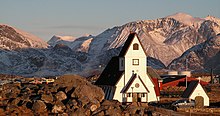
The nomadic Inuit were traditionally shamanistic, with a well-developed religion primarily concerned with appeasing a vengeful and fingerless sea goddess called Sedna who controlled the success of the seal and whale hunts.[190]
The first
Rediscovering these colonists and spreading ideas of the
Today, the major religion is
The
Social issues
The rate of suicide in Greenland is very high. According to a 2010 census, Greenland holds the highest suicide rate in the world.[197][198] Another significant social issue faced by Greenland is a high rate of alcoholism.[199] Alcohol consumption rates in Greenland reached their height in the 1980s, when it was twice as high as in Denmark, and had by 2010 fallen slightly below the average level of consumption in Denmark (which at the time were 12th highest in the world, but has since fallen). However, at the same time, alcohol prices are far higher, meaning that consumption has a large social impact.[200][201] Prevalence of HIV/AIDS used to be high in Greenland and peaked in the 1990s when the fatality rate also was relatively high. Through a number of initiatives the prevalence (along with the fatality rate through efficient treatment) has fallen and is now low, c. 0.13%,[202][203] below most other countries. In recent decades, the unemployment rates have generally been somewhat above those in Denmark;[204] in 2017, the rate was 6.8% in Greenland,[205] compared to 5.6% in Denmark.[206]
Fertility control
In the 1960s and 1970s, at a time when the population was increasing, 4,500 Greenland Inuit women and girls (roughly half of all fertile females) were fitted with intrauterine devices (IUDs) by Danish doctors. Sometimes girls (as young as 12) were taken directly from school to have these devices inserted, without parents' permission being sought. The procedure was also carried out on some Inuit girls at boarding schools in Denmark. On 30 September 2022, the Danish Health Minister, Magnus Heunicke, confirmed that a two-year investigation would try to find out what decisions led to the practice and how it was carried out.[207][208]
Culture

Today Greenlandic culture is a blending of traditional Inuit (
Music
Greenland also has a successful, albeit small, music culture. Some popular
The drum is the traditional Greenlandic instrument. It was used to perform traditional drum dances. For this purpose, a round drum (qilaat) in the form of a frame made of driftwood or walrus ribs covered with a polar bear bladder, polar bear stomach or walrus stomach was used. The drumming was not done on the membrane, but with a stick from underneath the frame. Simple melodies were sung for this purpose.
The drum dance used to serve two functions: On the one hand, the drum was used to drive away fear on long, dark winter nights. To do this, the drum dancer would make faces and try to make others laugh until all fear was forgotten.
Disputes were also settled with the drum. If someone had misbehaved, he was challenged with the drum. People would gather at certain powerful places and take turns beating the drum and singing to it. They tried to ridicule the other person as much as possible. The spectators expressed with their laughter who was the winner and who was therefore the guilty one.
The drum could also be used by shamans for ritual conjurations of spirits.
After the arrival of
Sport
Sport is an important part of Greenlandic culture, as the population is generally quite active.
Greenland has excellent conditions for
Cuisine

The national dish of Greenland is suaasat, a soup made from seal meat. Meat from marine mammals, game, birds, and fish play a large role in the Greenlandic diet. Due to the glacial landscape, most ingredients come from the ocean.[213] Spices are seldom used besides salt and pepper.[214] Greenlandic coffee is a "flaming" dessert coffee (set alight before serving) made with coffee, whiskey, Kahlúa, Grand Marnier, and whipped cream. It is stronger than the familiar Irish dessert coffee.[215]
Media
Kalaallit Nunaata Radioa (KNR) is the public broadcasting company of Greenland. It is an associate member of Eurovision and an associate member of the Nordvision network. Nearly one hundred people are directly employed by this company, which is one of the largest in the territory.[216] The city of Nuuk also has its own radio and television station. The city of Nuuk also has a local television channel, Nanoq Media, which was created on 1 August 2002. It is the largest local television station in Greenland, reaching more than 4,000 households as receiving members, which corresponds to about 75% of all households in the capital.[217]
Today only two newspapers are published in Greenland, both of which are distributed nationally. The Greenlandic weekly Sermitsiaq is published every Friday, while the online version is updated several times a day. It was distributed only in Nuuk until the 1980s. It is named after the mountain Sermitsiaq, located about 15 km (9.5 mi) northeast of Nuuk. The bi-weekly Atuagagdliutit/Grønlandsposten (AG) is the other newspaper in Greenland, published every Tuesday and Thursday in Greenlandic as Atuagagdliutit and in Danish as Grønlandsposten. The articles are all published in both languages.
Fine arts
The Inuit have their own arts and
The history of Greenlandic painting began with Aron von Kangeq, who depicted the old Greenlandic sagas and myths in his drawings and watercolours in the mid-19th century. In the 20th century, landscape and animal painting developed, as well as printmaking and book illustrations with sometimes expressive colouring. It was mainly through their landscape paintings that Kiistat Lund and Buuti Pedersen became known abroad. Anne-Birthe Hove chose themes from Greenlandic social life. There is a museum of fine arts in Nuuk, the Nuuk Art Museum.
See also
Other similar territories
Notes
- regional anthem but is generally used only in Greenland.[1]
- ^ a b Greenlandic has been the sole official language of Greenland since 2009.[2][4]
- ^ As of 2000: 410,449 km2 (158,475 sq mi) ice-free; 1,755,637 km2 (677,855 sq mi) ice-covered.
Density: 0.14/km2 (0.36/sq mi) for ice-free areas. - ^ Afro-Eurasia, the Americas, Australia, and Antarctica are all larger than Greenland; but they are generally considered continents, not islands.[17]
References
- ^ "03EM/01.25.01-50 Spørgsmål til Landsstyret: Hvornår fremsætter Landsstyret beslutning om Grønlands" [03EM/01.25.01-50 Questions to the Home Rule Government: When does the Home Rule Government make a decision on Greenland]. Government of Greenland. 7 October 2003. Archived from the original on 13 December 2014. Retrieved 13 December 2014.
- ^ a b c (in Danish) TV 2 Nyhederne – "Grønland går over til selvstyre" Archived 9 August 2023 at the Wayback Machine TV 2 Nyhederne (TV 2 News) – Ved overgangen til selvstyre, er grønlandsk nu det officielle sprog. Retrieved 22 January 2012.
- ^ "Self-rule introduced in Greenland". BBC News. 21 June 2009. Archived from the original on 25 April 2010. Retrieved 4 May 2010.
- ^ a b (in Danish) Law of Greenlandic Selfrule Archived 8 February 2012 at the Wayback Machine (see chapter 7)
- ^ "Bekendtgørelse af ILO-konvention nr. 169 af 28. juni 1989 vedrørende oprindelige folk og stammefolk i selvstændige stater". Retsinformation.dk (in Danish). 9 October 1997.
- ^ a b "The World Factbook – Central Intelligence Agency". cia.gov. Retrieved 3 October 2020.
- ^ "Population of Greenland". Greenlandic Population as of 2022.
- (PDF) from the original on 21 September 2013. Retrieved 2 September 2013.
- ^ a b "DANMARKS NATIONALBANK" (PDF), www.nationalbanken.dk
- ^ "Greenland | Data". data.worldbank.org. Retrieved 9 August 2021.
- ^ "GDP per capita (Current US$) - Greenland | Data".
- ^ "Gini Index coefficient". CIA World Factbook. Retrieved 16 July 2021.
- ISBN 978-0-87586-892-9.
- ^ "Greenland: The world's largest island". Denmark.dk.
- ^
- Dallen J. Timothy (6 November 2020). Tourism in European Microstates and Dependencies: Geopolitics, Scale and Resource Limitations. CABI. pp. 94–. OCLC 1162434605.
This ....This change in governance also resulted in Greenland becoming an autonomous 'constituent country' in the Danish realm...
- Benedikter, Thomas (19 June 2006). "The working autonomies in Europe". Society for Threatened Peoples.
Denmark has established very specific territorial autonomies with its two island territories
- Ackrén, Maria (November 2017). "Greenland". Autonomy Arrangements in the World. Archived from the original on 30 August 2019. Retrieved 30 August 2019.
Faroese and Greenlandic are seen as official regional languages in the self-governing territories belonging to Denmark.
- "Greenland". International Cooperation and Development. European Commission. 3 June 2013. Retrieved 27 August 2019.
Greenland [...] is an autonomous territory within the Kingdom of Denmark
- Dallen J. Timothy (6 November 2020). Tourism in European Microstates and Dependencies: Geopolitics, Scale and Resource Limitations. CABI. pp. 94–.
- ^ a b "Greenland". The World Factbook. CIA. Retrieved 13 January 2021.
- ^ "Joshua Calder's World Island Information". Worldislandinfo.com. Archived from the original on 23 April 2011. Retrieved 6 September 2010.
- ^ a b c The Fate of Greenland's Vikings Archived 11 January 2011 at the Wayback Machine, by Dale Mackenzie Brown, Archaeological Institute of America, 28 February 2000
- ^ "Saqqaq-kulturen kronologi". National Museum of Denmark. Archived from the original on 7 December 2013. Retrieved 2 August 2013.
- PMID 10924403.
- (PDF) from the original on 13 November 2012. Retrieved 10 February 2013.
- ^ Mcghee, Robert (3 April 2015). "Thule Culture". Canadian Encyclopedia. Historica Canada. Archived from the original on 20 November 2015. Retrieved 1 June 2015.
- ^ "Population of Greenland". Retrieved 12 August 2022.
- ^ "Population density (people per sq. km of land area)". The World Bank. Archived from the original on 5 June 2013. Retrieved 3 November 2012.
- ^ "Vedvarende energi". Nukissiorfiit. Retrieved 28 March 2023.
- ^ Eirik the Red's Saga. Gutenberg.org. 8 March 2006. Archived from the original on 11 May 2011. Retrieved 6 September 2010.
- ^ "How Greenland got its name" Archived 19 March 2012 at the Wayback Machine. The Ancient Standard. 17 December 2010.
- ^ S2CID 163032041. Archived from the originalon 11 April 2012.
- ^ Evans, Andrew. "Is Iceland Really Green and Greenland Really Icy?" Archived 4 December 2017 at the Wayback Machine, National Geographic (30 June 2016).
- ^ Stern, p. 89
- ^ Morison, Samuel Eliot (1975). History of United States Naval Operations in World War II, Volume 1: The Battle of the Atlantic September 1939 – May 1943. Boston: Little, Brown and Company. p. 62.
- .
- JSTOR 124963.
- ^ "The history of Greenland – From dog sled to snowmobile". Greenland.com. Archived from the original on 27 September 2011. Retrieved 10 September 2011.
- ^ "Migration to Greenland – the history of Greenland". Greenland.com. Archived from the original on 5 September 2011. Retrieved 10 September 2011.
- .
- ^ Ramsden, P.; Tuck, J. A. (2001). "A Comment on the Pre-Dorset/Dorset Transition in the Eastern Arctic". Anthropological Papers of the University of Alaska. New Series. 1: 7–11. Archived from the original on 8 April 2022.
- JSTOR 40316103.
- .
- ISBN 0-415-25255-5.
- ^ Gulløv, H. C. (1996). In search of the Dorset culture in the Thule culture. The Paleoo Cultures of Greenland. Copenhagen: Danish Polar Center (Publication No. 1). pp. 201–14.
- ^ Kudeba, N. (19 April 2014). Chapter 5, "Norse Explorers from Erik the Red to Leif Erikson", in Canadian Explorers.
- ^ "Viking Settlers in Greenland". Encyclopedia.com. Retrieved 18 December 2023.
- ISBN 0-7368-0939-2.
- ^ ISBN 978-0-14-303655-5.
- ^ a b Arnold C. (June 2010) "Cold Did In the Norse", Earth Magazine. p. 9.
- ISBN 978-3-406-52866-8. Retrieved 18 September 2022.
- from the original on 14 April 2018. Retrieved 16 August 2019.
- ^ "Why societies collapse Archived 2 August 2012 at the Wayback Machine". ABC Science.
- PMID 20212157.
- ^ ISBN 1-55081-158-4.
- ^ Bishop, Rosie R., et al. "A charcoal-rich horizon at Ø69, Greenland: evidence for vegetation burning during the Norse landnám?." Journal of Archaeological Science 40.11 (2013): 3890–902
- ISBN 978-3-319-12760-6.
- ^ Folger, Tim. "Why Did Greenland's Vikings Vanish?". Archived from the original on 17 March 2017. Retrieved 13 March 2017.
- ISBN 0-521-57393-9.
- ISBN 9781878100955.
- ^ "Inuit were not the first people to settle in the Arctic" Archived 9 November 2014 at the Wayback Machine, CBC News (Canada), 28 August 2014
- ^ Nebenzahl, Kenneth. Rand McNally Atlas of Columbus and The Great Discoveries (Rand McNally & Company; Genoa, Italy; 1990); The Cantino Planisphere, Lisbon, 1502, pp. 34–37.
- ^ Legal Status of Eastern Greenland Archived 11 May 2011 at the Wayback Machine, PCIJ Series A/B No. 53 (1933)
- ISBN 0-8179-8841-6.
- ^ Speer, Albert. Inside the Third Reich, 1971.
- ^ "Robert J. Walker on Acquiring Greenland and Iceland" (PDF). Archived (PDF) from the original on 16 August 2019. Retrieved 16 August 2019.
- ^ "Deepfreeze Defense". Time. 27 January 1947. Archived from the original on 21 February 2009. Retrieved 14 May 2008.
- ^ Miller, John J. (7 May 2001). "Let's Buy Greenland! — A complete missile-defense plan". National Review. Archived from the original on 7 January 2010.
- ^ Keil, Kathrin (29 August 2011) "U.S. Interests in Greenland – On a Path Towards Full Independence?", The Arctic Institute
- ^ Andrews Kurth LLP, "Oil and Gas in Greenland – Still on Ice?" Archived 19 October 2015 at the Wayback Machine, Andrewskurth.com. Retrieved on 21 June 2016.
- ^ Selsoe Sorensen, Martin (16 August 2019). "'Greenland Is Not for Sale': Trump's Talk of a Purchase Draws Derision". The New York Times. Archived from the original on 2 January 2022. Retrieved 21 August 2019.
- S2CID 142526881. Retrieved 15 August 2020.
- ^ "A Radioactive Cold War Military Base Will Soon Emerge From Greenland's Melting Ice". Smithsonian. 5 August 2016. Archived from the original on 20 August 2019. Retrieved 20 August 2019.
- ^ a b "Cataclysmic cargo: The hunt for four missing nuclear bombs after a B-52 crash". The Washington Post. 21 January 2018.
- ISBN 978-0-8020-9486-5. Archivedfrom the original on 13 April 2016.
- ^ Stern, pp. 55–56
- ^ Cowell, Alan (26 November 2008). "Greenland Vote Favors Independence". The New York Times. Archived from the original on 17 April 2009. Retrieved 4 May 2010.
- ^ "Vejledende folkeafstemning om selvstyre ? 25-11-2008" (in Kalaallisut). SermitValg. 26 November 2008. Archived from the original on 8 December 2008. Retrieved 26 November 2008.
- ^ "CIDOB – Secession and Counter-secession. An International Relations Perspective". CIDOB. p. 70. Archived from the original on 27 January 2018. Retrieved 19 May 2018.
- ^ Description of the Greenlandic Self-Government Act on the webpage of the Danish Ministry of State Archived 22 September 2014 at the Wayback Machine"The Self-Government Act provides for the Self-Government authorities to assume a number of new fields of responsibility, such as administration of justice, including the establishment of courts of law; the prison and probation service; the police; the field relating to company law, accounting and auditing; mineral resource activities; aviation; law of legal capacity, family law and succession law; aliens and border controls; the working environment; as well as financial regulation and supervision, cf. Schedule I and II in the Annex to the Self-Government Act."
- ^ Greenland takes step toward independence from Denmark Archived 18 July 2018 at the Wayback Machine. The Daily Telegraph (21 June 2009). Retrieved 29 September 2012.
- ^ "Nearly independent day". The Economist. 20 June 2009. Archived from the original on 25 June 2009. Retrieved 20 June 2009.
- ^ "Greenland set for self-rule". The Australian. 19 June 2009. Archived from the original on 24 June 2009. Retrieved 20 June 2009.
- ^ Boswell, Randy (19 June 2009). "Greenland takes big step towards full independence". Canwest News Services. Canada.com. Archived from the original on 24 June 2009. Retrieved 20 June 2009.
- ^ "Tourism Statistics Report 2019, Greenland" (PDF). Archived (PDF) from the original on 4 February 2021. Retrieved 12 January 2022.
- ^ "Greenland's Economy Autumn 2020, Summary" (PDF). Retrieved 27 March 2021.
- ^ "Greenland's economy is poised to rebound in 2021, 2 June 2020". 2 June 2020. Retrieved 27 March 2021.
- ^ Stephanie Vermillion (24 March 2021). "Greenland Is Approaching Tourism Slowly—And Taking Lessons from Iceland, 24 March 2021". Retrieved 20 January 2022.
- ^ "The Island of Greenland". Hidden Journeys – explore the world from the air. Archived from the original on 14 July 2014. Retrieved 8 July 2014.
- ^ "Demographic Yearbook – Table 3: Population by sex, rate of population increase, surface area, and density" (PDF). United Nations Statistics Division. 2008. Archived (PDF) from the original on 24 December 2010. Retrieved 24 September 2010.
- ^ "Boundary dispute". Global Affairs Canada. 14 June 2022. Retrieved 17 July 2023.
- ^ "WMO verifies −69.6°C Greenland temperature as Northern hemisphere record". World Meteorological Organization. 22 September 2020. Archived from the original on 18 December 2023.
- ^ "Nuuk, Greenland – Detailed climate information and monthly weather forecast". Weather Atlas. Yu Media Group. Archived from the original on 17 August 2019. Retrieved 17 August 2019.
- ^ "IPCC Climate Change 2001: Working Group I: The Scientific Basis". Grida.no. Archived from the original on 16 December 2007. Retrieved 6 September 2010.
- ^ "map (map on p. 4)". Archived from the original on 18 July 2011. Retrieved 6 September 2010.
- ^ DK Atlas, 2001.
- ^ Schneider, D. (2003). "American Scientist Online – Greenland or Whiteland?". Sigma Xi. Archived from the original on 10 May 2011. Retrieved 3 March 2008.
- ^ "Find Greenland Icecap Bridges Three Islands Archived 12 April 2016 at the Wayback Machine", Ellensburg Daily Record, 24 October 1951, p. 6. Retrieved 13 May 2012.
- ^ "The National Park". Greenland.com. Archived from the original on 27 June 2013. Retrieved 18 June 2013.
- ^ "Greenland Melt May Swamp LA, Other Cities, Study Says". National Geographic. Archived from the original on 10 May 2011. Retrieved 6 September 2010.
- ^ McCarthy, Michael (24 April 2007). "An island made by global warming". The Independent. London. Archived from the original on 30 August 2008. Retrieved 4 May 2010.
- ^ "Place of the Year". Blog.oup.com. 3 December 2007. Archived from the original on 15 October 2009. Retrieved 6 September 2010.
- ^ Publications, Usa Int'L Business. Denmark Company Laws and Regulations Handbook: Strategic Information and Basic Laws. Place of Publication Not Identified: Intl Business Pubns Usa, 2015. 20–21. Print.
- ^ Revkin, Andrew C. (28 April 2008). "Arctic Explorer Rebuts 'Warming Island' Critique". The New York Times. Archived from the original on 27 September 2010. Retrieved 6 September 2010.
- S2CID 233632072.
- S2CID 4468824.
- PMID 31010924.
- ^ Stendel, Martin; Mottram, Ruth (22 September 2022). "Guest post: How the Greenland ice sheet fared in 2022". Carbon Brief. Archived from the original on 22 October 2022. Retrieved 22 October 2022.
- S2CID 222147426.
- ^ "Greenland enters melt mode". Science News. 23 September 2013. Archived from the original on 5 August 2012. Retrieved 14 August 2012.
- ^ "Record melt: Greenland lost 586 billion tons of ice in 2019". phys.org. Archived from the original on 13 September 2020. Retrieved 6 September 2020.
- ^ Barnes, Adam (9 August 2021). "'Massive melting event' torpedoes billions of tons of ice the whole world depends on". The Hill. Archived from the original on 25 August 2021. Retrieved 24 August 2021.
Ice cores show that these widespread melt events were really rare prior to the 21st century, but since then, we have had several melt seasons.
- ^ Patel, Kasha (19 August 2021). "Rain falls at the summit of Greenland Ice Sheet for first time on record". Washington Post. Archived from the original on 19 August 2021. Retrieved 24 August 2021.
Rain fell on and off for 13 hours at the station, but staff are not certain exactly how much rain fell...there are no rain gauges at the summit because no one expected it to rain at this altitude.
- from the original on 23 October 2022. Retrieved 23 October 2022.
- .
- ^ Fox-Kemper, B.; Hewitt, H.T.; Xiao, C.; Aðalgeirsdóttir, G.; Drijfhout, S.S.; Edwards, T.L.; Golledge, N.R.; Hemer, M.; Kopp, R.E.; Krinner, G.; Mix, A. (2021). Masson-Delmotte, V.; Zhai, P.; Pirani, A.; Connors, S.L.; Péan, C.; Berger, S.; Caud, N.; Chen, Y.; Goldfarb, L. (eds.). "Chapter 9: Ocean, Cryosphere and Sea Level Change" (PDF). Climate Change 2021: The Physical Science Basis. Contribution of Working Group I to the Sixth Assessment Report of the Intergovernmental Panel on Climate Change. Cambridge University Press, Cambridge, UK and New York, NY, US. Archived (PDF) from the original on 24 October 2022. Retrieved 22 October 2022.
- ^ PMID 31223652.
- ^ "Melting Greenland ice sheet may affect global ocean circulation, future climate". Phys.org. 22 January 2016. Archived from the original on 19 August 2023. Retrieved 25 January 2016.
- PMID 26796579.
- S2CID 133069692.
- ISBN 9781009157896.
- S2CID 257774870.
- ^ "How Greenland would look without its ice sheet". BBC News. 14 December 2017. Archived from the original on 7 December 2023. Retrieved 7 December 2023.
- from the original on 14 November 2022. Retrieved 22 October 2022.
- ^ Armstrong McKay, David (9 September 2022). "Exceeding 1.5°C global warming could trigger multiple climate tipping points – paper explainer". climatetippingpoints.info. Archived from the original on 18 July 2023. Retrieved 2 October 2022.
- PMID 37853149.
- S2CID 259985096.
- ^ "Banded iron formation (BIF) deposits" (PDF). 9 March 2013. Archived from the original (PDF) on 9 March 2013. Retrieved 20 April 2021.
- ^ "Mineralienatlas – Fossilienatlas". www.mineralienatlas.de (in German). Retrieved 20 April 2021.
- ISSN 2245-7070.
- S2CID 257756028.
- ISSN 1424-2818.
- S2CID 91179289.
- PMID 28608869.
- ^ a b "Greenland Wildlife". Redaction. The Great Danish Encyclopedia. 2014. Archived from the original on 13 March 2016. Retrieved 8 October 2015.
- ^ "Greenland". Encyclopædia Britannica, Eleventh Edition.
- ^ "Animal life in Greenland – an introduction by the tourist board". Greenland Guide. Narsaq Tourist Office. n.d. Archived from the original on 27 April 2012. Retrieved 1 May 2012.
- OCLC 551668689.
- ^ "Economy and Industry in Greenland - Naalakkersuisut". naalakkersuisut.gl. Archived from the original on 2 April 2019. Retrieved 17 August 2019.
- .
- ISBN 82-90307-53-5.
- ^ "Greenland". PeakVisor. Retrieved 2 October 2023.
- ^ Seabird Harvest in the Arctic - Prepared by the Circumpolar Seabird Group (CBird) (Report). Conservation of Arctic Flora and Fauna. September 2008. Retrieved 2 October 2023.
- ^ "Inatsisartut" (in Kalaallisut). Inatsisartut.gl. Retrieved 29 December 2020.[permanent dead link]
- ^ "The executive power is vested in the King." The Constitution of Denmark – Section 3. Archived 10 July 2011 at the Wayback Machine
- ^ "The body of Ministers shall form the Council of State, in which the Successor to the Throne shall have a seat when he is of age. The Council of State shall be presided over by the King..." The Constitution of Denmark – Section 17. Archived 10 July 2011 at the Wayback Machine
- ^ The Monarchy today Archived 15 February 2015 at the Wayback Machine – The Danish Monarchy (kongehuset.dk). Access date: 16 June 2012
- ^ "The King shall not be answerable for his actions; his person shall be sacrosanct." The Constitution of Denmark – Section 13. Archived 10 July 2011 at the Wayback Machine
- ^ "EU Relations with Greenland". European Union. Archived from the original on 9 June 2011. Retrieved 3 October 2020.
- ^ "Overseas Countries and Territories (OCT)". European Union. Archived from the original on 13 August 2011. Retrieved 3 October 2020.
- ^ Folketinget – Folketinget.dk Archived 28 June 2015 at the Wayback Machine. Ft.dk. Retrieved on 21 June 2016.
- ^ "Múte Egede er ny formand for Naalakkersuisut". KNR (in Danish). Retrieved 23 April 2021.
- ^ "Trump reportedly wants to 'buy' Greenland. This is what it's like at the US's Arctic base there". Business Insider. 16 August 2019. Archived from the original on 19 August 2019. Retrieved 19 August 2019.
- ^ Hansen, H. C. (16 November 1957). "Danish Prime Minister Gives Tacit Go-Ahead For U.S. Nuclear Weapons in Greenland". The Nautilus Institute. Archived from the original on 6 November 2007. Retrieved 20 March 2009.
- ^ "A Top-Secret US Military Base Will Melt Out of the Greenland Ice Sheet". VICE Magazine. 9 March 2019. Archived from the original on 20 August 2019. Retrieved 20 August 2019.
- ^ "The Cold War's Missing Atom Bombs". Der Spiegel. 14 November 2008. Archived from the original on 27 June 2019. Retrieved 20 August 2019.
- ^ "US B-52 nuclear bomber crash in Greenland 51 years ago has ill Danes seeking compensation". Fox News. 3 June 2019. Archived from the original on 8 June 2019. Retrieved 20 August 2019.
- ^ Corera, Gordon (10 November 2008). "Mystery of lost US nuclear bomb". BBC News.
- ^ "US left nuclear weapon under ice in Greenland". The Daily Telegraph. 11 November 2008. Archived from the original on 20 August 2019. Retrieved 20 August 2019.
- ^ from the original on 29 January 2017. Retrieved 28 January 2017.
- ^ a b "Greenland". CIA World Factbook. Retrieved 15 May 2007.
- ^ COHEN, LI (16 July 2021). "Greenland halts new oil exploration to combat climate change and focus on sustainable development". CBC. Retrieved 20 July 2021.
- ^ "Greenland's red hot labour market". Nordic Labour Journal. 12 October 2011. Archived from the original on 1 February 2013. Retrieved 10 February 2013.
- BusinessWeek.
- ^ "Greenland Rubies: What We Know At This Point | National Jeweler". www.nationaljeweler.com. Archived from the original on 17 August 2019. Retrieved 17 August 2019.
- ^ "Greenland – Transportation". www.iexplore.com. Archived from the original on 10 October 2018. Retrieved 10 October 2018.
- ^ "ATV-sporet mellem Sisimiut og Kangerlussuaq bliver færdig næste år" (in Danish). Qeqqata Kommunia. 25 May 2023. Retrieved 30 December 2023.
- ^ "ATV-sporet mellem Kangerlussuaq og Sisimiut er færdig" (in Danish). Sermitsiaq. 25 September 2011. Retrieved 30 December 2023.
- ^ "Hönnun vegar á milli Sisimiut og Kangerlussuaq – verkfræðilegar áskoranir í óbyggðum Grænlands" (in Icelandic). Verkís. 3 July 2023. Retrieved 30 December 2023.
- ^ "Forslag: Naalakkersuisut bør punge ud til grusvej til omkring 500 mio. kr" (in Danish). Sermitsiaq. 27 March 2023. Retrieved 30 December 2023.
- ^ "Mittarfeqarfiit, Grønlands Lufthavne, Greenland Airports Today's Flights Airports Kangerlussuaq airport – mit.gl". www.mit.gl.
- ^ "tripsta". Archived from the original on 21 September 2019. Retrieved 3 January 2020.
- ^ "City, high-rise apartments, cosy atmosphere, culture, rock, gourmet restaurants, cafés, fashion outlets, art, the national museum and the university – all the ingredients of a capital - Nuuk - airgreenland.com". www.airgreenland.gl.
- ^ "Nuuk Airport". www.mit.gl.
- ^ "Ilulissat Airport". www.mit.gl.
- ^ Perrin, Wendy (21 July 2015). "Greenland Day Trip from Iceland: Is it Worth It?". Wendy Perrin. Archived from the original on 26 December 2017. Retrieved 25 December 2017.
- ^ "Historical Maiden Flight US-Greenland – Official national guide by Greenland Tourism and Business Council". Greenland.com. 24 May 2007. Archived from the original on 6 October 2008. Retrieved 6 September 2010.
- ^ "Air Greenland teams with First Air for Iqaluit flights". CBC News. 7 June 2012. Archived from the original on 10 June 2012. Retrieved 19 August 2012.
- ^ "The Baltimore route is to close". Air Greenland. 12 June 2010. Archived from the original on 18 May 2013.
- ^ "4 Ways to Get to Greenland". Fodor's. 26 February 2014. Archived from the original on 26 December 2017. Retrieved 25 December 2017.
- ISBN 978-1-68181-946-4.
- ^ "Greenland in Figures 2021" (PDF). Greenland in Figures 2021. Archived (PDF) from the original on 2 June 2021. Retrieved 8 December 2021.
- ^ "Greenland". Stalvik.com. Archived from the original on 23 September 2010. Retrieved 6 September 2010.
- PMID 25557782.
- ^ "Greenland". citypopulation.de. Retrieved 22 August 2021.
- ^ "Danish doubts over Greenland vote". BBC News. 27 November 2008. Archived from the original on 7 December 2012. Retrieved 10 February 2013.
- ^ Kleinschmidt, Samuel 1968 (1851): Grammatik der grønlændischen Sprache : mit teilweisem Einschluss des Labradordialekts. Hildesheim : Olms, 1968.
- ^ "Travelling in Greenland". Greenland Representation to the EU, Greenland Home Rule Government. Archived from the original on 16 May 2014.
- ^ Mennecier, Philippe (1978). Le tunumiisut, dialecte inuit du Groenland oriental: description et analyse, Collection linguistique, 78, Societé de linguistique de Paris.
- ^ "Atlas of the world's languages in danger". unesdoc.unesco.org. Retrieved 21 February 2023.
- ^ "Sermersooq will secure Eastern Greenlandic" (in Danish). Kalaallit Nunaata Radioa. 6 January 2010. Archived from the original on 16 May 2016. Retrieved 19 May 2010.
- ^ "Greenland, Religion and Social Profile | National Profiles | International Data". Thearda.com. 21 June 2009. Archived from the original on 24 September 2017. Retrieved 18 June 2016.
- ^ "Table: Christian Population as Percentages of Total Population by Country | Pew Research Center". 19 December 2011. Archived from the original on 11 May 2017. Retrieved 27 September 2017.
- ISBN 978-1-351-03988-8.
- ^ Sørensen, Leif Kiil (29 November 2000). "Grønlandsk bibel præsenteret | Kristeligt Dagblad". Kristeligt-dagblad.dk. Archived from the original on 11 May 2011. Retrieved 6 September 2010.
- ^ "Bells ring a wake-up call for climate justice." World Council of Churches. 14 December 2010. Retrieved 30 August 2010
- ^ "Grønland, Grundloven og Gejstligheden" (PDF). Archived from the original (PDF) on 25 April 2012. Retrieved 30 April 2012.
- ^ "Constitution of Denmark – Section IV" (PDF). Archived (PDF) from the original on 1 March 2016. Retrieved 22 September 2016.
The Evangelical Lutheran Church shall be the Established Church of Denmark, and, as such, it shall be supported by the State.
- ^ "The only Muslim in Greenland who fasts for 21 hours". The Jazba Blog. 8 August 2011. Retrieved 26 January 2020.
- ^ "Greenland | Operation World". Operation World. Retrieved 10 September 2020.
- ^ "The Suicide Capital of the World". Slate. 9 October 2009. Archived from the original on 4 March 2013. Retrieved 13 March 2013.
- ^ "Rising suicide rate baffles Greenland". Archived from the original on 23 March 2013. Retrieved 13 March 2013.
- ^ "Greenland profile – Overview" Archived 18 September 2018 at the Wayback Machine. BBC News.
- PMID 23256091.
- PMID 16050317.
- PMID 23431117.
- ^ "Nye tilfælde af HIV blandt unge". Naalakkersuisut. 13 October 2019. Archived from the original on 23 November 2019. Retrieved 22 November 2019.
- ^ "Arbejde". europas-lande.dk. Archived from the original on 23 November 2019. Retrieved 22 November 2019.
- ^ "Unemployment rate". Statistics Greenland. 2017. Retrieved 22 November 2019.[permanent dead link]
- ^ "Euro area unemployment at 8.7%, December 2017" (PDF). Eurostat. Archived (PDF) from the original on 12 February 2018. Retrieved 22 November 2019.
- ^ "Inuit Greenlanders demand answers over Danish birth control scandal". BBC News. 30 September 2022.
- ^ "Spiralkampagnen 1:5 - 4500 spiraler". 6 May 2022 – via open.spotify.com.
- ^ Hessel, p. 20
- ^ Hessel, p. 21
- ^ Wilcox and Latif, p. 109
- ^ Wilcox and Latif, p. 110
- ^ "Greenland – Greenlandic cuisine – Official Greenland Travel Guide". 14 April 2010. Archived from the original on 14 April 2010. Retrieved 16 July 2019.
- ^ "Greenland – Traditional Greenlandic food – Official Greenland Travel Guide". 27 March 2010. Archived from the original on 27 March 2010. Retrieved 16 July 2019.
- ^ "Greenland – Greenlandic coffee – Official Greenland Travel Guide". 30 March 2010. Archived from the original on 30 March 2010. Retrieved 28 July 2019.
- ^ "Kalaallit Nunaata Radioa | KNR". knr.gl. Retrieved 19 April 2021.
- ^ "Nanoq Media". nanoqmedia.gl. Retrieved 19 April 2021.
- ^ "The making of a tupilak and its consequences". Museon.
Bibliography
- Hessel, Ingo (2006). Arctic Spirit. Vancouver, BC: Douglas and McIntyre. ISBN 978-1-55365-189-5.
- Oldendow, Knud.(1958). "Printing in Greenland". Libri: International Journal of Libraries & Information Services 8 (3/4): 223–62.
- Stern, Pamela (2004). Historical Dictionary of the Inuit. Lanham, Maryland: The Scarecrow Press, Inc. OCLC 54768167.
- Wilcox, Jonathan; Latif, Zawiah Abdul (2007). Cultures of the World: Iceland. Marshall Cavendish. ISBN 978-0-7614-2074-3.
Works cited
- Bardarson, I. (ed. Jónsson, F.) "Det gamle Grønlands beskrivelse af Ívar Bárðarson (Ivar Bårdssön)", (Copenhagen, 1930) (in Danish).
- CIA World Factbook, 2000.
- Conkling, P. W.et al. 2011. The Fate of Greenland: Lessons from Abrupt Climate Change, co-authored with Richard Alley, Wallace Broecker and George Denton, with photographs by Gary Comer, MIT Press, Cambridge, Massachusetts.
- Lund, S (1959). "The Marine Algae of East Greenland. 1. Taxonomical Part". Meddr Gronland. 156 (1): 1–245.
- Lund, S (1959). "The Marine Algae of East Greenland. 11. Geographic Distribution". Meddr Gronland. 156: 1–70.
- Steffen, Konrad, N. Cullen, and R. Huff (2005). "Climate variability and trends along the western slope of the Greenland Ice Sheet during 1991–2004", Proceedings of the 85th American Meteorological Society Annual Meeting (San Diego).
- Sowa, F (2013). "Indigenous Peoples and the Institutionalization of the Convention on Biological Diversity in Greenland". Arctic Anthropology. 50 (1): 72–88. S2CID 143294645.
- Sowa, F. 2013. Relations of Power & Domination in a World Polity: The Politics of Indigeneity & National Identity in Greenland. In: Heininen, L. Arctic Yearbook 2013. The Arctic of regions vs. the globalized Arctic. Akureyri: Northern Research Forum, pp. 184–198.www.arcticyearbook.com/ay2013
- Sowa, F. 2014. Greenland. in: Hund, A. Antarctica and the Arctic Circle: A Geographic Encyclopedia of the Earth's Polar Regions. Santa Barbara, California: ABC-CLIO, pp. 312–316.
External links
- Brown, Robert (1880). . Encyclopædia Britannica. Vol. XI (9th ed.). pp. 166–171.
- Nansen, Fridtjof Wedel-Jarlsberg (1911). . Encyclopædia Britannica. Vol. 12 (11th ed.). pp. 542–548.
- Greenland Archived 6 September 2018 at the Wayback Machine entry at Denmark.dk.
- Greenland at Curlie
- The Government of Greenland Offices official website Archived 2 March 2016 at the Wayback Machine
- Visit Greenland – the official Greenlandic Tourist Board
- Inuit Circumpolar Council Greenland



